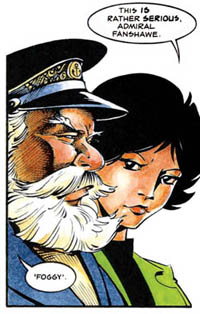 Written by Grant Morrison
Written by Grant Morrison
Art by Ian Gibson
32 pages, color
Published by Boom! Studios
When Eclipse published Steed and Mrs. Peel twenty years ago, I knew who Grant Morrison and Ian Gibson were, but had never actually watched an episode of The Avengers television show. I’ve since fixed the latter omission in my entertainment knowledge, so it’s nice to have Boom! Studios bringing this long-out-of-print series back to life for another go-round. And so far? Well, like any story involving John Steed, Emma Peel, and Tara King, it’s a mixed bag.
 Steed and Mrs. Peel takes place after the end of The Avengers television show, but still strongly within its continuity. Steed and Tara are still working for "Mother" (introduced in the Steed and King episodes that closed out the series), and after Tara has gone missing on a solo investigation, Steed has called up his old partner Mrs. Peel. The presence of Mother and an organization in general sending Steed out on assignments is just as regrettable now as it was on the television show; given the choice of using or quietly discarding the idea, I’ll admit to being disappointed that Morrison stuck so rigidly to the setup.
Steed and Mrs. Peel takes place after the end of The Avengers television show, but still strongly within its continuity. Steed and Tara are still working for "Mother" (introduced in the Steed and King episodes that closed out the series), and after Tara has gone missing on a solo investigation, Steed has called up his old partner Mrs. Peel. The presence of Mother and an organization in general sending Steed out on assignments is just as regrettable now as it was on the television show; given the choice of using or quietly discarding the idea, I’ll admit to being disappointed that Morrison stuck so rigidly to the setup.
On the plus side, Steed and Mrs. Peel both feel spot-on. Steed’s still got his general suave nature, and Mrs. Peel’s playful personality shines through so much that I could almost hear Diana Rigg delivering her lines. It’s that interplay between the two that punctuated a lot of the entertainment from their episodes of The Avengers, and it works well here. When the pair of them visit Fanshawe’s home, Morrison places them inside all of the massive games that fill the estate, and it felt like a missing scene right out of their era. Playing with the ship in the bottle, making quips involving both the board game Clue (or Cluedo in their case) and if the butler did it… Morrison clearly loved those episodes of The Avengers, too. Fans of Tara King might be a little disappointed here; she’s barely in the story, and comes across as a bit naive when she does. Still, it’s her disappearance that spurs the rest of the story, so it’s only understandable that she’s hardly a star.

Gibson’s art is a bit variable in Steed and Mrs. Peel. It’s difficult to work off of real-life likenesses, of course, but it’s hard to ignore when the looks are a bit off-kilter. When Gibson gets it right, it looks fantastic; Mrs. Peel sitting on the desk at the magazine office, for instance, exudes the confidence and sexuality that was a hallmark of the character. On the other hand, the title page image of Mrs. Peel looks almost like someone else entirely, and in general the art veers back and forth between careful renditions and what feels like squiggled faces. Mrs. Peel playing hopscotch looks more like an electrocuted scarecrow than an actual person, and while I appreciate that Gibson is bringing his own slightly cartoonish style to the comic, it veers a little too far off-course every now and then.
The original Steed and Mrs. Peel was a three-issue mini-series, but with each issue having two chapters worth of story, it makes the split into a six-issue series here rather painless. (The main story, "The Golden Game," only runs four chapters with the remaining two chapters being drawn by Gibson but written by Anne Caulfield instead, with a story about the return of the infamous Mr. Peel.) It’s fun to see Steed and Mrs. Peel dusted off, and based off of this I’d certainly be happy to see Morrison—or just comic books in general—take another crack at the property. There’s definitely still some life in these characters.
